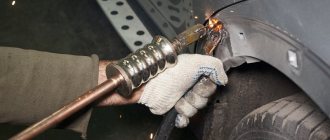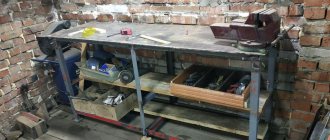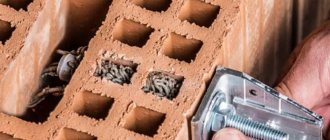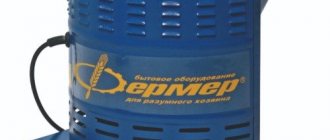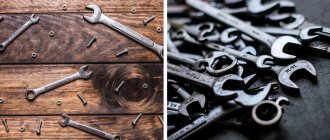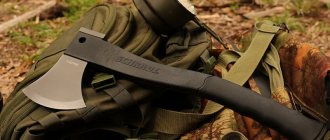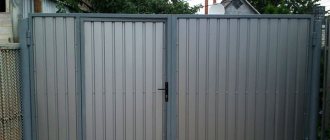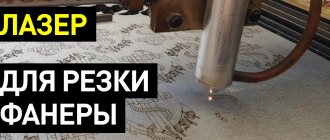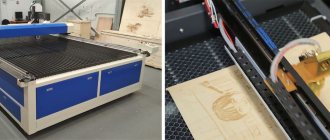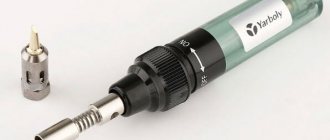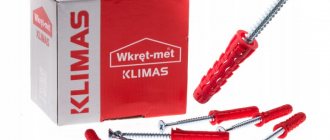Many of those who have had to deal with straightening car body parts know firsthand what spotters are and how convenient they are when performing such work. These devices got their name from the English phrase spot welding, which means “spot welding”. The spotter uses one of the varieties of this technology - one-sided spot welding, which does not require access to the back side of the part. Therefore, a spotter is used for straightening and upsetting defects in body elements to which two-way access is impossible or difficult.
The spotter consists of a pulse-controlled welding machine and a hand-held device, which is commonly called a gun. It is equipped with various attachments, which allows them to perform various types of work: spot welding, mechanical drawing and metal annealing. In its most general form, the technology for straightening a body part using a spotter looks like this: special fasteners (rings, studs, etc.) are welded to a dent in the metal, then the body metal is pulled upward using a mechanical device, after which the fasteners are removed.
What is a spotter and how does it work?
Spot welding is used to connect parts made of thin sheet metal to each other, as well as to fix various fastening and supporting elements on them. Welding is carried out with a short and powerful current pulse. This ensures that the metal sheet does not penetrate to the full depth and thus avoids damage to its surface on the reverse side. Therefore, the power sources of many spotters have an open circuit voltage of 6÷8 V, a welding voltage of 1.5÷2 V and a pulse current of the order of 2500÷3000 A, which allows welding on a metal sheet with a thickness of 0.5 to 1.5 mm.
This apparatus for straightening body parts includes five main components (see figure below):
- power supply with a relay or electronic control and regulation unit;
- welding cable with control wires;
- ground cable with plate;
- a gun with terminals for connecting the power and control circuits and a threaded connection for electrodes;
- set of electrodes, accessories and consumables.
The design and operating principle of the spotter is based on the technology of pulling out dents in sheet metal using fasteners welded to its surface by spot welding. In this case, the gun simultaneously performs two functions: welding fasteners and creating a pulling force.
Straightening using a spotter occurs in the following order:
- Cleaning the dent surface.
- Welding outside the working area of the ground cable plate.
- Installing an electrode into the gun and clamping fasteners into it (ring, nail).
- Welding fasteners to the exhaust area with a short pulse.
- Pulling out a dent in a body part manually or using devices.
- Boiling fasteners from the metal surface.
Various devices are used with the spotter: reverse hammers, hooks, combs, etc.
Features of straightening
Let's look at what a straightening spotter is and how to use it. The principle of eliminating damage is the same for dents, regardless of their size:
- Cleaning and preparing repair areas.
- Installation of the ground terminal.
- Fixing the tip of the electrode of the equipment or the consumable washer on the dent.
- Pulling metal using lever systems, pullers, blows of a reverse hammer, as well as other methods
- Subsequent finishing.
For small dents, a lever puller is sufficient . With its help, damage is eliminated in one step.
Dents that occupy a large area and have a complex shape are straightened using a reverse hammer.
Repairing serious damage, such as deep longitudinal dents, requires the use of additional consumables.
Purpose and scope of equipment
Spotters are standard equipment for car repair shops, as their use significantly saves time and reduces labor costs when straightening body parts with one-way access.
In addition, they are used for upsetting metal by pulse heating. Another area of application for spotters is double-sided welding. In this case, instead of a gun, special welding pliers are used. One of the important features of this welding equipment is low power consumption; The PV parameter (on duration) for such devices does not exceed 5%. Many home craftsmen involved in car body repairs make their own spotters from scrap materials (mostly based on old transformers). In such devices, most often there is no electronic control unit, and the welding pulse is generated manually by pressing the power off button. As a rule, they also do not have current adjustment, so the selection of welding modes is done experimentally. Craftsmen usually make pistols and reverse hammers with their own hands, and purchase consumable fasteners in specialized stores. Nevertheless, with the help of such devices, various types of straightening are quite successfully performed.
Required material
You can often hear from familiar car service workers that a battery spotter is in no way inferior to a regular one. It is advisable to take an old battery for it: firstly, you won’t mind it, and secondly, it will operate at a current close to the short circuit current. Of course, the service life of such a product will be shorter than the operation of an ordinary spotter, but the money spent on the purchase will be more than covered by the reduced costs of car repairs.
To make a battery spotter, you will need:
- battery. A model with 75A/h and higher is suitable;
- solenoid relay. Use the component from the car starter;
- battery charger;
- copper wire with a cross-section of more than 100 m2;
- reverse hammer. It can be replaced by a gun that welds washers.
Electrical circuit of the spotter The spotter from the battery and the solenoid relay is connected as shown in the diagram, namely:
- the relay body is connected to the negative terminal, as well as a wire no more than 1.5 m long. At the end of the wire there is a contact intended for the body of the part that will be pulled. It is good if you use a copper thread contact to ensure minimal resistance in the place in contact with the part;
- The positive terminal is connected to the relay with your own hands using a bolt. The second bolt from the relay attaches the wire to it that goes to the recoil hammer or gun. The positive cable should not be longer than 2.5 m. This will reduce the voltage drop in the cable;
- From the positive terminal also connect the wire to the control contact. Complete the wire with a button that will control the battery spotter. The length of the conductor for the button is not strictly fixed.
A solenoid relay is installed on the battery to connect multiple contacts. If you have the opportunity, install a detachable relay that you can remove and clean at any time. If the inner part can be pulled out, it needs to be shortened and rolled. This prevents stem loss. This is where all relay transformations end.
In addition, you will need to install a button yourself to control the impulse.
It is mounted either on the wire itself or on the gun. The part is connected from a positively charged wire (in a car, the cable from the ignition switch goes to this contact). There are no specific requirements for the properties of a homemade button - it needs to withstand 5-7 A of current.
Solenoid relay for battery spotter
Also pay attention to the wires. Working with them will be effective when you take a short and thick cable. Its length should be less than 1.5 m and limited by losses in the product itself, because welding is characterized by high currents.
You can even build a gun for welding parts with your own hands from wood, and a holder for washers can be made from brass or copper. You can use an air conditioner tube and make a slit at the end of the small tube. This will make it possible to conveniently insert the washer into place.
Before starting work, charge the battery. Accordingly, after work, put the device back on charge.
Types of spotters
As a rule, spotters are classified according to the type of power source, weight and size indicators and functionality, as well as power and standard operating time. In the first case, they are divided into transformer and inverter. Transformer ones are available in both manual and stationary versions, while inverter ones are available only in stationary versions. The functionality of the spotter largely depends on the type of power source and its power, which determines the maximum thickness of the products being welded. For example, manual machines are intended only for welding fastening nails in fixed modes. At the same time, professional stationary inverter spotters can perform both types of spot welding (gun and pliers), as well as annealing with carbon electrodes. In addition, the inverter allows you to generate current pulses of any shape and duration, which is very important when working on thin-sheet products made of various metals and alloys.
How to work as a spotter
Working as a spotter does not require special training, but in order to become a real specialist, you still need certain qualifications in working with car body parts. The behavior of the metal depends on the size, depth and nature of the deformation. Therefore, before starting straightening, it is necessary to correctly determine what needs to be done and what method will be used to straighten the dent on the body part. And only after that the appropriate fastening materials are selected. The following is used as a welded fastener to which a pulling force is applied:
- cylindrical nails;
- triangular washers;
- rings;
- rivets;
- wavy wire.
Each of these elements corresponds to its own type of replaceable electrodes, which are attached to the end, a gun and its own type of equipment (hooks, clamps, combs, cartridges, return hammers) with which they are pulled. There are many types of electrodes for spotters, and the most common types are designed for welding:
- corrugated wire;
- screw studs;
- rivets;
- round washers;
- nuts;
- using a reverse hammer;
- nails
In addition, copper and carbon electrodes can be used with the spotter, which makes it possible to perform the reverse operation of pulling: annealing and deposition of bulges on the body parts of the car (the so-called flappers).
With sequential point pulling, straightening is used with a spotter with a triangular washer and a reverse hammer, which allows you to carefully and without much effort pull out the metal at the welding site. If the defect has a large extent, then first one or two rows of rings or corrugated wire are welded along the entire length. The extraction is carried out using a comb with rows of hooks. This provides simultaneous pulling force on 5–10 wire rings or protrusions. After the extraction is completed, all elements are boiled using the same electrodes that were used when installing them.
How to choose equipment
When choosing a specific spotter model, first of all, it is necessary to answer the question: why is this equipment purchased and what types of work are it supposed to perform. Not only the indicators of power, controllability, weight and dimensions, but also its price depend on the functionality of the device. For example, the simplest manual spotter for welding nails can cost 6–7 thousand rubles, and the price of an inverter unit with the ability to work with various non-ferrous metals, double-sided welding of sheets more than 1.5 mm thick and a wide range of adjustable parameters can reach 80–90 thousand . rubles. Important criteria are the type of supply network (three- or single-phase), as well as the dimensions of the installation and the length of the cables. For a small car service with several repair stations, a device with the following characteristics is quite suitable:
- single-phase network 220 V;
- power - 2.5÷3 kW;
- pulse current - 2500÷3000 A;
- power adjustment;
- weight - 12÷15 kg.
Such a model, depending on additional functions, can cost from 25 to 30 thousand rubles, which is not prohibitive for small businesses.
What is digital control of a welding machine?
Modern spotters are equipped with a microprocessor, which automates the entire welding process. You can adjust welding parameters by entering the thickness of the workpieces being welded into the system, rather than setting the amperage manually, which can be time-consuming. In addition, the equipment can adjust the value of the welding current and welding time, depending on the parameters of the power supply network, which allows you to obtain a high-quality weld point. When replacing equipment, the working tool is automatically recognized, and, based on this, the operation of the cooling system is automatically adjusted, for example, when the heating temperature of the holder reaches the maximum permissible value, cooled air is supplied.
Main manufacturers and models
Spotters are specialized equipment, so compared to other welding machines on the market, they are represented by a much smaller number of models.
Perhaps the most famous among them are the Italian Telwin and the German Garwin and Nordeberg. All these companies produce quite expensive inverter models with the widest range of functionality. The rest of the range is represented by well-known and little-known brands that produce their equipment in China. Among them we can note the German brand Fubag, which produces a variety of welding equipment with a good reputation. In articles about spotters, there are sometimes statements that in spot welding mode you can use welding inverters with manual mode (MMA). Considering the difference in open circuit voltages (even taking into account the possibility of regulation), this looks rather doubtful. What do you think about this? Please share your opinion in the comments.
